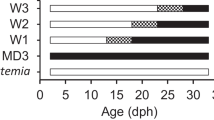Abstract
Two age groups of juvenile Synodontis petricola (Group I, 0.5 years and Group II, 1.5 years) were reared on each of five diets: formulated dry diet; Artemia; Spirulina; formulated diet plus Artemia; and formulated diet plus Spirulina. Fish were fed for 84 days and weighed and measured every 14 days. Growth of S. petricola averaged 0.06 mm/day for both age groups. There was no significant difference in percent survival between the fish fed on different diets within each of the two groups but the younger fish (0.5 years) had a significantly lower survival percentage (90.3%) than those in Group II (95.3%). Fish in Group I fed on Spirulina alone grew slower than those fed only on formulated dry feed, whereas the growth rates of fish fed on other diets, or diet combinations, did not differ from each other in both age groups.
Similar content being viewed by others
REFERENCES
Allen, B. (1995) Breeding Synodontis multipunctatus. Tropical Fish Hobbyist 43(10), 146-135.
Appler, H. and Jauncey, K. (1983) The utilization of a filamentous green alga (Cladophora glomerata(L)Kutzin) as a protein source in pellet feeds for Sarotherodon(Tilapia) niloticusfingerlings. Aquaculture 30, 21-29.
Colditz, G. (1992) The strange life of Synodontis multipunctatus. Tropical Fish Hobbyist 40(6), 130-134.
Coulter, W. (1991) Lake Tanganyika and its Life. Oxford University Press. 354 pp.
Davis, J.A. (1992) The potential of effluent-grown Spirulinaas dietary protein and as colour enhancing agent and food supplement for ornamental fish. Honours Thesis. Department of Ichthyology and Fisheries Science, Rhodes University, South Africa.
Dhert, P., Lim, L.C., Candreva, P., Van Duffel, H. and Sorgeloos, P. (1997) Possible applications of modern larviculture technology to ornamental fish production. Aquarium Sciences and Conservation 1, 119-128.
Endemann, F., Kaiser, H. and Hecht, T. (1997) Size-sorted juvenile swordtails, Xiphophorus helleriHeckel 1848 (Family Poeciliidae), do not show improved growth. Aquaculture Research 28, 645-647.
Fermin, A.C. and Recometa, R.D. (1988) Larval rearing of bighead carp, Aristichthys nobilisRichardson, using different types of feed and their combinations. Aquaculture and Fisheries Management 19, 283-290.
Geier, M. (1998) Beobachtungen bei der Zucht von Synodontis multipunctatus. Deutsche Aquarien und Terrarien Zeitschrift, DATZ 51(1), 17-19.
Hanssen, M. (1982) Spirulina, Nature's Diet Supplement Rediscovered. Thorsons Publishers Ltd. Northamptonshire.
Hecht, T. and Pienaar, A.G. (1993) A review of cannibalism and its implications in fish larviculture. Journal of the World Aquaculture Society 24(2), 246-260.
Hepher, B. (1988) Nutrition of Pond Fishes. Cambridge University Press. 388 pp.
Jobling, M. (1983) A short review and critique of methodology in fish growth and nutrition studies. Journal of Fish Biology 23, 685-703.
Kestemont, P. and Melard, C. (1991) Quantitative feed requirements of goldfish Carassius auratuslarvae fed with a mixed diet. European Aquaculture Society, Special PublicationNo. 15, 157-159.
Kruger, D.P. (1995) Aspects of nutrition of the swordtail fish, Xiphophorus helleri(Family Poeciliidae) under intensive culture conditions. Master of Science Thesis, Rhodes University, South Africa, 84 pp.
Legendre, M. and Albaret, J.J. (1991) Maximum observed length as an indicator of growth rate in tropical fishes. Aquaculture 94(4), 327-341.
Lovell, R.T. (1989) Nutrition and Feeding of Fish. New York: Von Nostrand Reinhold. pp. 129-138.
Mart, B.A. (1992) The biotechnology of effluent-grown Spirulina, and application in aquaculture nutrition. Master of Science Thesis, Department of Biotechnology, Rhodes University, 208 pp.
Mills, D., Stone, D., Newton, P. and Willis, S. (1993) A comparison of three diets for larval goldfish rearing. Austasia Aquaculture 7(1), 48-49.
Nakazoe, J., Kimura, S., Yokoyama, M. and Iida, H. (1986) Effects of the supplementation of algae or lipids to the diets on the growth and body composition of nibbler Girella punctataGrey. Bulletin of the Tokai Region Fisheries Research Laboratory 120, 43-51.
Potts, W. M. (1998) A nutritional evaluation of effluent-grown algae and zooplankton as feed ingredients for Xiphophorus helleri, Poecilia reticulataand Poecilia velifera(Pisces: Poeciliidae). Master of Science Thesis, Rhodes University, South Africa, 131 pp.
Prinsloo, J.F. and Schoonbee, H.J. (1986) Comparison of the early larval growth rates of the Chinese grass carp Ctenopharyngodon idellaand the chinese silver carp Hypophthalmichthys nobilisusing live and artificial feed. Water SA 12(4), 229-234.
Rottmann, R.W., Shireman, J.V. and Lincoln, E.P. (1991) Comparison of three live food and two dry diets for intensive culture of grass carp and bighead carp larvae. Aquaculture 96, 269-280.
Rouhani, Q.A. (1997) The breeding and rearing of Synodontis petricola. Research Report Series 10 (January 1997). Department of Ichthyology and Fisheries Science, Rhodes University, South Africa.
Usher, B. (1997) Breeding Synodontis multipunctatus. Cichlidae 18, 2-6.
Watanabe, T., Kitajima, C. and Fujita, S. (1983) Nutritional values of live organisms used in Japan for mass propagation of fish: a review. Aquaculture 34, 115-143.
Watanabe, T., Liao, W., Takeuchi, T. and Yamamoto, H. (1990) Effect of dietary Spirulinasupplementation on growth performance and flesh lipids of cultured jack. Journal of the Tokyo University of Fisheries 77(20), 231-239.
Zar, J.H. (1984) Biostatistical Analysis. NJ: Prentice Hall. 718 pp.
Author information
Authors and Affiliations
Rights and permissions
About this article
Cite this article
Kaiser, H., Rouhani, Q. Growth of Juvenile Synodontis petricola (Family: Mochokidae) Fed on a Formulated Diet, Artemia or Spirulina and Combinations Thereof. Aquarium Sciences and Conservation 2, 117–123 (1998). https://doi.org/10.1023/A:1009606107770
Issue Date:
DOI: https://doi.org/10.1023/A:1009606107770




